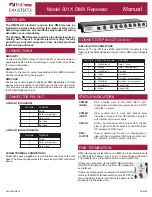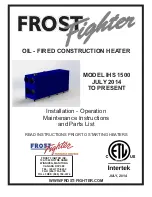
14
12.3 - CLEARANCES TO SHELVES & COMBUSTIBLE MATERIALS
a.
We do not recommend the use of combustible shelves in this application.*
We do not recommend the use of a
non-combustible
shelf in this application.*
However, see section 13 which shows the application where a
non-combustible
shelf is used.
c.
Any combustible sidewall must be at least 500mm from the inside of the Fireplace opening.
d.
With all heating appliances, soft furnishings, decorations and wall coverings may discolour or scorch if placed too close.
e.
No combustible material, e.g. curtains must be closer than 500mm to the fireplace enclosure..
*The wall between the sealing frame and any shelf would become hot. Therefore, we do not recommend any shelves with this type of instal-
lation.
12.4 - CUTTING THE HOLE FOR THE FLUE
The flue is 150mm in diameter, and a hole is required providing sufficient clearance. The following Notes will assist:
a.
If cutting the hole with a core drill ensure the pilot hole is cutting into solid material as it may wander.
b.
Partially drill or cut out the hole and then check the fit of the flue before finishing.
c.
Ensure the hole is horizontal, round and straight.
d.
Make good the hole on both the inside and outside (a Wall Plate is provided for the outside).
e.
Any Cavity Wall insulation must be trimmed and sealed back from the hole by at least 50mm to prevent contact with the flue.
12.5 - PREPARING THE FLUE
a.
The Flue Length supplied caters for a Maximum Flue Length of
500mm, and a Minimum Flue Length of 93mm.
(Total Flue Length of flue supplied Including Terminal = 630mm).
b.
To find the flue length required in your application
;
measure the
Depth from the front face of the Fireplace to the Outside Wall. For the
Fire with Sealing Frame deduct 343mm or without Sealing Frame deduct
359mm (ref page 9) from this dimension; this will provide the flue length
for your application.
Take your flue length dimension from 500mm, (maximum wall flue
length provided), and this is the length you will need to cut off the flue.
See Diagram with Example.
c.
From the open end of the flue mark the cut off dimension, position the
cutting aid in the flue central about the cut line and cut the flue,
ensuring it is cut square; remove any sharp edges.
Remove the Cutting Aid Material from inside the Flue.
d).
With the flue at the correct length and when the fire is fitted there should be 130mm of Flue Terminal Outside The Wall and
the screw holes for fixing the Wall Plate should line up with those in the Flue Terminal. See photographs on next page
! IMPORTANT NOTE !
NONE OF THE SQUARE HOLES IN THE FLUE TERMINAL MUST BE WITHIN THE WALL
.
! TIP !
To provide a good square cut end to the flue, working form the Open end of the flue; place 5 marks around the flue
and using a tape measure coiled around the flue mark a continuous line.
! IMPORTANT NOTE !
Numerous problems occur because the cutting aid is not removed after cutting the flue.
! IMPORTANT NOTE !
Numerous problems occur because the correct length of the flue is not first determined and the
square cut outs in the flue terminal are not outside the flue. Check that the Wall Plate screws can
be fitted into the Flue.
! IMPORTANT NOTE !
Do NOT FORCE the flue when engaged into the flue spigot; it goes in just 40mm up to a stop and
will block off the flow creating a poor flame picture and overheating if pushed in too far.
FLUE LENGTH DIAGRAM - EXAMPLE
Depth for Fire used with the Sealing Frame = 343mm
Inside Wall to Outside Wall Dimension = 595mm
Deduct the Appropriate Fire Depth:
595mm – 343mm = 252mm
Take this from the 500mm Flue Length Supplied:
500mm – 252mm = 248mm.
Cut 248mm off the Open End of the Flue
NOTE: The Depth of the Fire can be different .
Check Which Application Applies on Page 9.















































